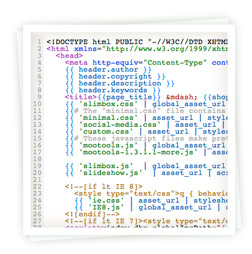 We’ve always believed in pushing the technical envelope to provide advanced technical solutions to make life easier for our store owners. This is way more important to us than the hype and gloss that you may find in the rest of the industry.
We’ve always believed in pushing the technical envelope to provide advanced technical solutions to make life easier for our store owners. This is way more important to us than the hype and gloss that you may find in the rest of the industry.
Over the past year, we’ve been talking to loads of web designers who use Spiffy Stores to create online stores for their customers. Although they love creating new e-commerce shops using our software, the resounding feedback we’ve been getting is that whilst the current Theme Editor in the Toolbox is great for small changes, it get’s a bit more difficult when designing an entire theme for a store.
For larger theme updates it’s really necessary to download the theme files to your computer, edit them and then upload the new files to the server. Using the Theme Editor to do this is a bit cumbersome, and makes the design process more difficult than it should be.
We’ve listened to these concerns, and have spent considerable time and effort working on a solution… so today we’re very proud to announce a major new capability which allows all your theme files and assets to be edited directly from your computer using WebDAV enabled editors such as Adobe’s Dreamweaver, and Panic’s Coda. If you’re on a Mac, you’re even luckier, as WebDAV is built right into OSX, and can be used in conjunction with TextMate and Taco.
To use this new feature in Windows, all you need is a WebDAV enabled editor or a utility such as NetDrive which allows WebDAV files to be mounted on your computer as a local folder. This means that you can use your favourite editor to edit your store’s theme files directly from your computer.
If you’re using a WebDAV enabled editor such as Dreamweaver, you also have access to some advanced features such a file checkout and locking so that you can work in a team without having to worry about whether someone else overwrites your changes.
If you’re a web designer and your current e-commerce software doesn’t support WebDAV, then you should seriously consider Spiffy Stores for this feature alone, as you’ll find your theme development time slashed significantly.
For more info about using WebDAV to edit your store, head over to the WebDAV section of our knowledge base.
 Until now the Theme Editor has displayed your theme’s Liquid template files in a very boring, black text field.
Until now the Theme Editor has displayed your theme’s Liquid template files in a very boring, black text field.